Qeswachaca, the last remaining Inca suspension bridge, is a remarkable feat of engineering nestled in the heart of the Andes. Constructed entirely from the durable ichu grass, this iconic bridge spans 28 meters over the Apurimac River, standing 12 meters high. Maintained annually by local communities, Qeswachaca embodies the ingenuity and cultural traditions of the Inca civilization. Visitors can witness the intricate craftsmanship involved in the bridge’s upkeep, which offers a unique glimpse into the rich history and enduring legacy of this remarkable structure. But what makes Qeswachaca truly remarkable is its ability to transport travelers back in time, allowing them to…
Key Points
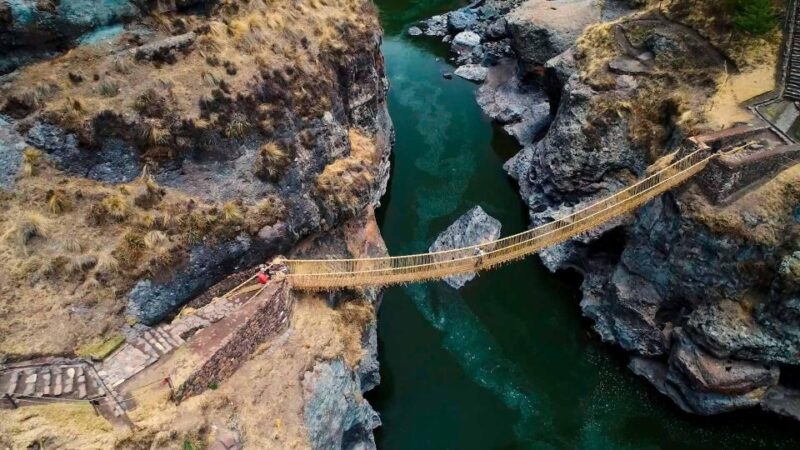
- Qeswachaca is the last remaining Inca bridge, constructed entirely from hardy ichu grass and connecting communities across the Apurimac River.
- The bridge, standing 12 meters above the river, represents the ingenuity and adaptability of the Inca civilization.
- Locals maintain the bridge annually, reflecting the Quechua tradition and showcasing indigenous knowledge and stewardship.
- Visitors can witness the bridge maintenance ritual and explore the impressive 28-meter span of the structure.
- Caution is advised when visiting the fragile bridge, as it requires following the guide’s instructions to preserve its integrity.
Overview of Qeswachaca Tour
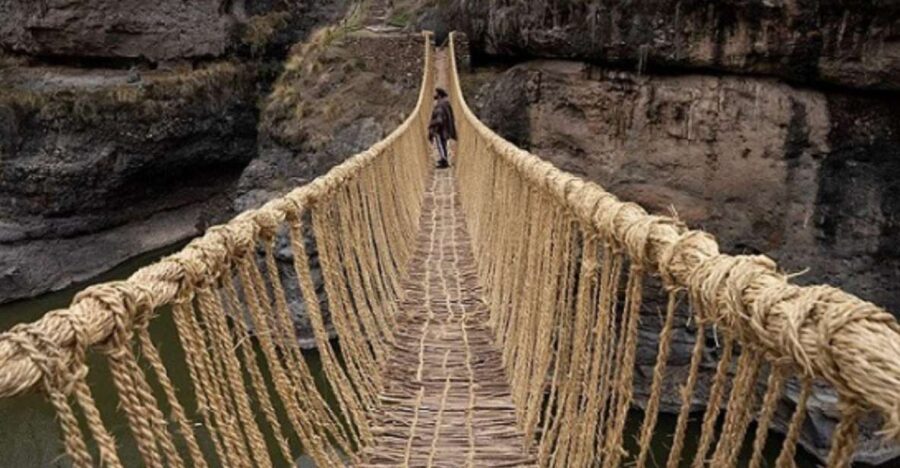
What does a visit to the last Inca bridge, Qeswachaca, entail? The tour lasts one day and costs $45 per person, with free cancellation up to 24 hours in advance.
Pickup is around 5 AM from accommodations near Cusco’s historic center, and the tour includes visits to four lagoons and a small volcano before reaching the main attraction – the Inca bridge over the Apurimac River.
Made of vegetable fiber and maintained annually by locals, the bridge is compared to the colonial bridge of Checacupe.
The tour also includes round-trip transport, a bilingual guide, meals, entrance fees, and travel insurance, wrapping up around 5 PM back in Cusco.
You can also read our reviews of more tours and experiences in Cusco.
Itinerary and Highlights
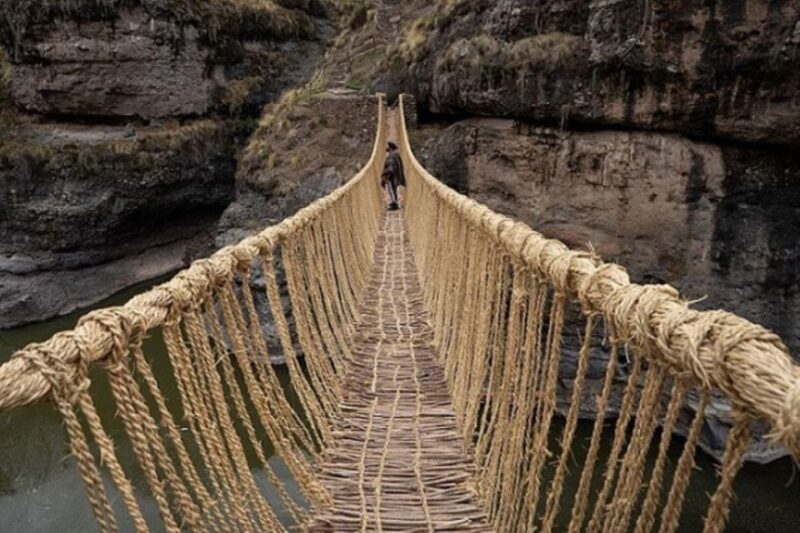
The tour begins with a morning pickup from accommodations near Cusco’s historic center, typically around 5:00 AM. The first stop is a visit to four lagoons and a small volcano near Yanaoca. The main attraction, however, is the iconic Inca bridge over the Apurimac River in Quechue district, made of vegetable fiber (Ichu) and maintained annually by locals. The tour also includes a visit to the colonial bridge of Checacupe to compare it with the Qeswachaca. Participants return to Cusco around 5:00 PM.
| Activity | Location | Duration |
|---|---|---|
| Visit four lagoons and small volcano | Pabellones near Yanaoca | – |
| Visit Inca bridge over Apurimac River | Quechue district | – |
| Visit colonial bridge of Checacupe | Checacupe | – |
| Return to Cusco | – | Approximately 5:00 PM |
Inclusions and Exclusions
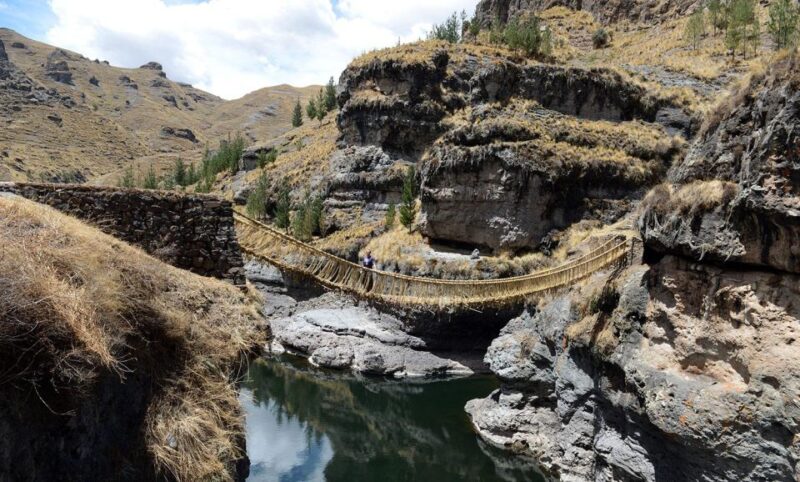
The tour includes round trip transport, a bilingual professional guide, breakfast and lunch, and the entrance fee to the Qeswachaca bridge.
Travel insurance is also provided. However, the tour excludes any extra expenses and dinner.
Participants will need to bring their passport or ID card, sunglasses, and sunscreen.
The tour is available at various start times, and the meeting point can be found by opening the provided Google Maps link.
Booking is flexible, allowing you to reserve now and pay later.
With these inclusions and exclusions, the Qeswachaca tour provides a comprehensive experience to explore this last Inca bridge.
What to Bring
Passport or ID card, sunglasses, and sunscreen are the essential items participants should bring along for the Qeswachaca tour. The tour involves exploring the outdoors, so it’s important to protect oneself from the sun.
| What to Bring | Why |
|---|---|
| Comfortable hiking shoes | For walking on uneven terrain |
| Warm layers | The weather can be cool at the bridge site |
| Snacks and water | To stay energized and hydrated during the day |
Plus, participants may want to bring a camera to capture the stunning views of the Apurimac River and the ancient Inca bridge.
More Great Thing To Do NearbyBooking and Availability
Checking availability for starting times is the first step in booking the Qeswachaca tour. Visitors can check the tour’s availability on the provider’s website or contact them directly.
Once the desired starting time and date are confirmed, participants and the number of people in the group can be selected. The meeting point for the tour is provided as a Google Maps link, making it easy to find the starting location.
Booking the Qeswachaca tour is flexible, allowing visitors to reserve their spot now and pay later. With free cancellation up to 24 hours in advance, travelers can plan their trip with confidence.
History and Cultural Significance
As a testament to the enduring legacy of the Inca Empire, the Qeswachaca bridge stands as a remarkable feat of engineering and a symbol of cultural resilience.
This intricate suspension bridge, constructed entirely from the fibrous Ichu grass, has connected communities across the Apurimac River for centuries. Maintained through an annual ritual by locals, the bridge’s preservation reflects the deep-rooted traditions and communal spirit of the Quechua people.
Its very existence defies the passage of time, offering a tangible link to the ingenuity and adaptability that defined the Inca civilization.
Today, Qeswachaca continues to captivate visitors, serving as a testament to the enduring power of indigenous knowledge and collective stewardship.
Unique Features of the Bridge
Towering 12 meters above the rushing Apurimac River, the Qeswachaca bridge captivates onlookers with its intricate construction and timeless elegance.
This magnificent structure, the last remaining Inca bridge, is a testament to the engineering prowess of the ancient civilization.
Its unique features include:
-
Woven from hardy ichu grass, the bridge is painstakingly reconstructed each year by the local community, preserving a centuries-old tradition.
-
The bridge’s design features a series of ropes and cables that form a sturdy, yet flexible platform, allowing it to adapt to the river’s fluctuating levels.
-
The bridge’s impressive span of 28 meters connects the two banks of the Apurimac, serving as a vital link for the local population and a captivating attraction for visitors.
Tips for Visiting Qeswachaca
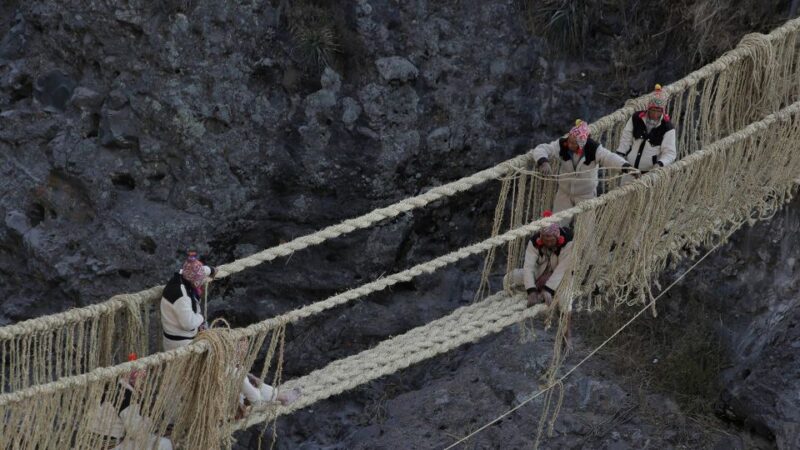
With the captivating Qeswachaca bridge firmly established in visitors’ minds, it’s important to consider a few practical tips to make the most of this unique experience.
Arrive early to beat the crowds and witness the locals’ annual bridge maintenance ritual. Wear comfortable shoes and bring sun protection, as the bridge is exposed to the elements.
Pack a hearty snack or lunch, as the remote location lacks dining options. Plus, be mindful of the bridge’s fragility and follow any instructions from the guide to preserve its historical integrity.
Frequently Asked Questions
What Is the Best Time of Year to Visit Qeswachaca?
The best time to visit Qeswachaca is during the dry season, typically from May to September. This ensures optimal weather conditions and access to the Inca bridge, which is maintained annually by locals during this time of year.
How Accessible Is the Bridge for People With Disabilities?
The Qeswachaca bridge isn’t highly accessible for people with disabilities. There are no paved pathways or railings, and the bridge itself is made of woven grass which can be uneven and slippery. Visitors with mobility issues may struggle to reach and traverse the bridge.
Can I Take My Pet on the Tour?
Pets are not allowed on the Qeswachaca tour. The tour itinerary and inclusions do not mention pets, and the tour operator likely prohibits them for safety and logistical reasons. Travelers should leave their pets at home when booking this day trip.
Are There Any Recommended Side Trips or Activities Near Qeswachaca?
The tour doesn’t include any recommended side trips, but visitors can explore the nearby four lagoons and small volcano of Pabellones. They can also visit the colonial bridge of Checacupe to compare it with the Qeswachaca bridge.
What Is the Typical Group Size for the Qeswachaca Tour?
The typical group size for the Qeswachaca tour ranges from 4 to 12 participants. The tour operator maintains small groups to provide a more intimate and personalized experience for visitors exploring this historic Inca bridge.
Recap
Visiting Qeswachaca, the last remaining Inca bridge, is a unique opportunity to witness a remarkable feat of engineering and experience the cultural traditions of the Andes. Maintained yearly by local communities, the bridge stands as a testament to the ingenuity of the Inca civilization and invites visitors to explore its rich history and intricate craftsmanship, making it a must-see destination for those exploring the region.
You can check if your dates are available here:More Tour Reviews in Cusco
- From Cusco: Uros Excursion to Uros Island – Taquile + Lunch.
- Adventure 13D in Peru and Bolivia – Machu Picchu |Hotel☆☆☆☆|
- Cusco, Sacred Valley, Machupicchu, Rainbow Mountain in 6 Day
- From Cusco: Ausangate Trek + Rainbow Mountain 6d/5n
- From Cusco: Machu Picchu Fantastic 4D/3N + Hotel ☆☆
- The New Inca Routes
Not for you? Here's more things to do in Cusco we have recnetly reviewed
- 2 Best Canoe And Kayak Experiences In Cusco
- 2 Best Tours In Paucartambo
- 20 Best 2 Day Tours In Cusco
- 20 Best 3 Day Tours In Cusco
- 20 Best 4 Day Tours In Cusco
- 9 Best Dining Experiences In Cusco
- 20 Best Full-Day Tours In Cusco
- 4 Best Coffee Tours And Tastings In Cusco
- 9 Best Massage And Relaxation Services In Cusco
- 8 Best Dinner Tours In Cusco
- 25 Best Lunch Experiences In Cusco
- 19 Best Food Tours In Cusco
